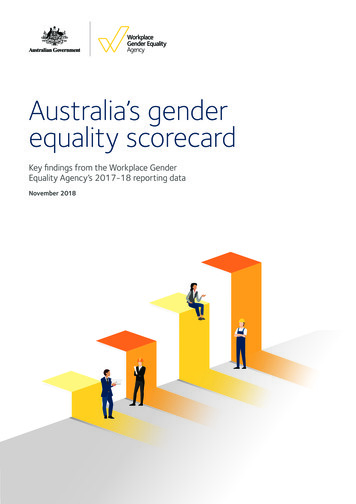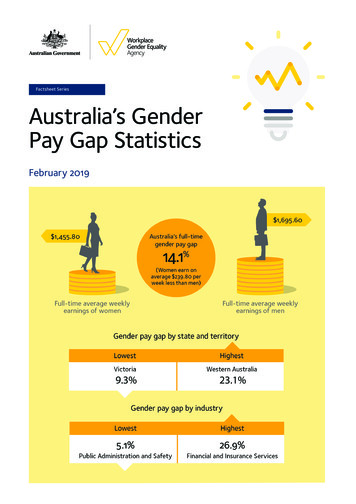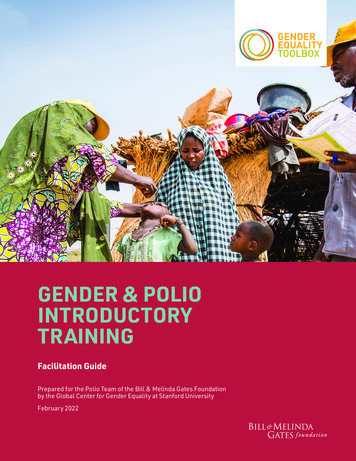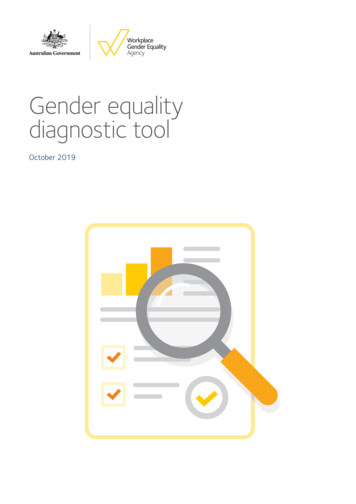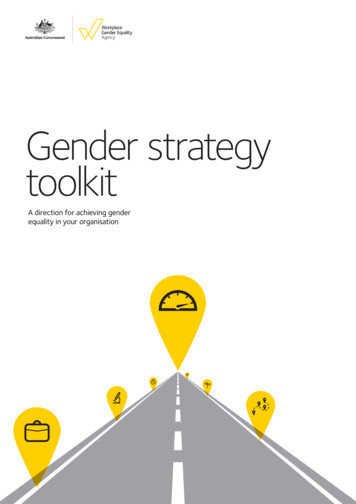
Transcription
Gender strategytoolkitA direction for achieving genderequality in your organisation
ContentsIntroduction1The gender equality journey1Why is a gender equality strategy important?2The change process3Navigating the toolkit3Section 1: The business case for gender equality4How gender equality supports business performance5Section 2: The gender equality roadmap10On-ramp points and express lanes13Section 3: The gender equality diagnostic tool16Key focus areas17Section 4: Mapping your current position20Using the Gender Equality Diagnostic Tool21Scoring22Overall assessment35Section 5: Planning your journey36Creating or refining your strategy37Section 6: Making the journey42Section 7: Travelling faster45Reviewing your strategy and action plans46Appendix A: Suggested metrics48Appendix B: Example objectives49Appendix C: Examples of strategies on a page56
IntroductionAddressing gender equality within organisations willnot happen accidentally, and like any other businessissue, a strategic and systematic approach is required.The gender equality journeyAims of the toolkitGender equality in the workplace is achieved when all employeesare able to access and enjoy the same rewards, resources andopportunities regardless of whether they are a woman or a man.Our goal in providing this toolkit is to equip organisations withthe skills and resources to accelerate strategic, sustainable andmeaningful change.This toolkit has been developed to help organisations leveragethe value of the benchmark data in a strategic, structured andsustainable way. The toolkit also provides guidance for thoseorganisations aiming to adopt best practice or become WGEAEmployer of Choice for Gender Equality1 (EOCGE).Addressing gender equality within organisations will not happenaccidentally, and like any other business issue, a strategic andsystematic approach is required. The process of achieving genderequality is often referred to as a ‘journey’. This is because theend-state or ‘destination’ (i.e. a workplace which is genuinelyand sustainably equitable to both women and men) can only beachieved over time, and through a series of stages, which arecumulative in their impact.The toolkit assists organisations starting on the gender equalityjourney and those already on the journey wanting to makefaster and more effective progress – by making better decisionswhich result in appropriate, well-targeted actions, and doing thissystematically (i.e. in a sequence which delivers desired outcomesas efficiently as possible). Central to this is the design andimplementation of a gender strategy.A key starting point for many organisations is through annualreporting to the Workplace Gender Equality Agency (WGEA).The Workplace Gender Equality Act 2012 requires all non-publicsector employers with 100 or more employees to report to theAgency in a standardised format on gender outcomes, includingin areas such as workforce composition, pay and flexible work. Inreturn, the WGEA provides feedback to each of these employersin the form of confidential, customised Competitor AnalysisBenchmark Reports on their gender performance.A well-constructed gender strategy provides the fundamentalframework by which organisations can navigate and acceleratetheir own unique gender equality journey. In the followingsections of this toolkit, we explain how to build an effectivegender strategy, and how to use this to generate momentumand sustainable progress. In section 3, we highlight specificopportunities to maximise progress (which we refer to as ‘onramps’ and ‘express lanes’).These Reports provide a powerful business intelligence tool,enabling employers to compare their gender performance to theirpeers, identify areas for improvement and track the effectivenessof their gender equality strategies over time.This data is unique. No similar benchmarking data is available toemployers in Australia. It provides employers with the evidencebase to pinpoint their efforts to improve gender equality in theirworkplaces.1. Identify the on-ramp points to the gender equality journeyProvides the ‘how’Showcase best practiceThe toolkit contains advice on leading practices, which reflectboth contemporary research and ongoing learning fromworkplace application of concepts by organisations which startedtheir journey some time ago. Employers that are just recognisingthe need to start their gender equality journey can benefitsignificantly from this learning.A strategic approach to gender equality is a prerequisite for the WGEA Employerof Choice for Gender Equality citation (criterion 1) and an essential underpinningfor meeting other criteria.IntroductionGender strategy toolkit Workplace Gender Equality Agency1
Who is this toolkit for?Any individual who is a stakeholder in workplace gender equalityand has the potential to influence an organisation’s approach togender issues should find some or all of the frameworks and ideasuseful. Such stakeholders are likely to include business leaders andmanagers, diversity champions and sponsors within organisations,and human resources or diversity practitioners.From an organisational perspective, we recognise that genderequality starting points and levels of readiness and maturity willdiffer, and have therefore attempted to accommodate the resultingrange of needs. We envisage several different scenarios in whichthe toolkit will be relevant, in particular: Organisations that have recently started (or are aboutto start) their gender equality journey. Often the hardestquestion is “where do we start?” and “what does progress looklike?” The toolkit helps to answer these questions and provides astructured approach for prioritising effort and investment.Organisations that have already started their genderequality journey. Their question may be “how can we makefaster progress?” or “how can we achieve more impact fromour effort?” Here, the toolkit can be used more selectively, toidentify and help fill gaps in approaches (especially those thatlack strategic direction) and enable stakeholders to avoid pitfallsand wasted effort from well-intentioned but poorly-targetedinitiatives and investment (e.g. which address symptoms ratherthan root causes).The underlying assumptionof this toolkit is that a morestrategic approach to genderequality will support broaderbusiness objectives.Advantages of a strategic approach Concerted action: all parts of the organisation are workingand moving in a similar, consistent direction. Well-targeted investment: every program or initiative canbe tested before proceeding: will it help achieve the strategicobjectives that have been agreed? Synergies: organisations can avoid ‘re-inventing the wheel’ byadopting similar approaches that are mutually supportive andenable avoidance of mistakes and wasted effort. Economies of scale: sharing information and resources acrossthe organisation and using collective commercial power (e.g.use of external vendors / service providers) to increase costeffectiveness. Consistency of approach: when different business unitsor teams approach gender equality similarly, employees’experience of the workplace is consistent and predictable,wherever they are deployed internally; this fosters engagementand productivity. Mobilisation and motivation: a strategy provides a basis forcommunicating intent, engaging stakeholders around specificobjectives and building long-term support. A basis for measuring success: clarity of direction and purposeprovides a robust basis for measuring progress and success,including return on investment. Reporting requirements: adopting a more strategic approachto gender equality will assist organisations to meet their WGEAreporting obligations, e.g. in relation to GEI 1, which containsquestions in relation to strategy. Adopting a strategic approachwill enable employers to answer ‘yes’ to questions wherethey previously responded ‘no’, helping them improve theirperformance against reporting matters.Why is a gender equalitystrategy important?A strategy defines a range of objectives in a particular area ofendeavour and the underlying business rationale. Typically, it willalso indicate how these objectives will be realised, and providesan assessment of risks and success factors. Developing specificproject plans for discrete initiatives will also provide the detailof how the strategy is executed. Without a strategy, it is eitherdifficult or impossible to gauge whether day-to-day activityand investment are helping the organisation effectively progresstowards the desired end-goal.Achievement of gender equality outcomes is no different. Theunderlying assumption of this toolkit is that when organisationsuse it to become more strategic in their approach to genderequality, the resulting strategy will link to, and support, broaderbusiness strategies and objectives.IntroductionGender strategy toolkit Workplace Gender Equality Agency2
The change processThe gender equality journey involves a process of change:the end-point is different from the start. There is a significantbody of learning from organisations that have, for a range ofreasons, needed to change the way they operate or conducttheir business. As a result, there are many different models andproprietary tools for managing organisational change.The goal of this toolkit is not to substitute any of these. Instead,it aims to provide a simple, strategic framework for identifyingand taking action in relation to gender equality that is consistentwith generic change management approaches. It can also beeasily integrated into a specific change methodology already usedby an organisation. It aims to reflect established core changemanagement principles.To achieve this, the toolkit is structured around the foursteps which typically guide change programs. These steps aresummarised below and are explained in more detail in the toolkitsections which follow.The diagram below shows how each of the WGEA tools andresources relate to each of the steps in the change process: Throughout: the gender equality roadmap provides anoverarching means of assessing progress towards the desiredend state, and milestones in between. Step A: the gender equality diagnostic tool provides a robustframework for analysing where an organisation is currentlypositioned on the gender equality journey, and helps to identifythe opportunities and challenges in terms of making better andfaster progress. Step B: a gender equality strategy has to be produced by eachorganisation for itself, informed by the roadmap and diagnosticanalysis and using the guidelines contained within this toolkit. Step C: the achievement of each strategic objective will occurthrough an action (or implementation or project) plan for eachactivity, program or initiative that is identified and agreed bystakeholders. Step D: Competitor Analysis Benchmark Reports will providenew insights for organisations and a means of assessingprogress relative to industry or other external comparators; thediagnostic can continue to be used as a means of re-evaluatingprogress at any time, relative to gender equality best practice.Navigating the toolkitThe toolkit is intended to be logical and intuitive. Before definingand describing the gender equality journey, it explains thebenefits of making the journey – i.e. the business case. Afterexplaining the gender equality journey, the toolkit describes theessential building blocks of an effective gender equality strategy.These elements are then put together to create a ‘diagnostic’,which organisations can use to assess their current genderequality status and performance, and identify any gaps andweaknesses in their approach. This insight provides the basis fortaking action to improve these shortfalls, including appropriatesequencing and prioritisation.The toolkit also provides a robust and consistent way fororganisations to evaluate their current and future gender equalityachievements, as well as their progress over time. The WGEA‘building a gender equality strategy’ webpages provides a centralhub of resources on developing specific actions and strategies oneach of the key focus areas discussed in this document.Figure 1: The step change processA) AnalyseB) DesignC) ImplementWhat is the bestroute to get there?How can we start(or keep) moving?D) ReviewWhere are we now? Wheredo we want to be (and why)?GENDER EQUALITYDIAGNOSTICGENDER EQUALITYSTRATEGYGENDER EQUALITYACTION PLANSGENDER EQUALITYBENCHMARKSIntroductionHow are we travelling?Gender strategy toolkit Workplace Gender Equality Agency3
Section 1The business casefor gender equality
Section 1The business case for gender equalityToo frequently there isinsufficient focus given to thedevelopment, endorsementand socialisation of a robustand credible business casefor gender equality.A business case for gender equality is an essential prerequisite forbuilding commitment to a gender strategy and its implementation.This principle is valid not only for commercial organisations, but alsoin a public or third (voluntary / not-for-profit) sector context.Too frequently there is insufficient focus given to the development,endorsement and socialisation of a robust and credible businesscase for gender equality. Weakness at this stage of the strategydevelopment process has the potential to undermine the successof everything that follows, as a business case is usually critical tostakeholder support. Reliance on a sense of corporate responsibilityor supportive individual or collective attitudes and values is not bestpractice or a sound approach as it is usually insufficient ina commercial context.Section 1 The business case for gender equalityThe learnings from organisational experience indicate approachesto the gender equality business case often suffer from a numberof the following limitations: reliance on a generic business case instead of developing aspecific one, unique to the organisation no gathering or utilisation of relevant and compelling data(quantitative and qualitative) to substantiate the business case the specific business case is not cascaded or redefined for subunits or teams within the organisation key stakeholder understanding is limited to parts of the business case key stakeholders have an intellectual appreciation of thebusiness case but lack belief or conviction in its validity the business case it not actively communicated or promotedacross the organisation no attempt is made to measure impact or return on investmentarising from gender equality action in order to retrospectivelydemonstrate the legitimacy of the business case (and use thisto build future support).Gender strategy toolkit Workplace Gender Equality Agency5
Tailoring the business caseThe generic business case for gender equality is a good startingpoint for building support for gender equality action within yourorganisation, but it should not be regarded as sufficient on itsown. Typically, stakeholders such as leaders and middle-managerswant to know the specific benefits to them, their team or theirwhole business. It will usually be up to human resource or diversitymanagers to define the specific business case.There are two types of input which will help answer the question “whatis the specific business case for gender equality here?” These are: Quantitative inputs: what does the data indicate are yourbiggest gender issues? It could be gender imbalance withinleadership or executive teams, disproportionate loss of femaletalent, or a disconnect between the gender diversity ofcustomer and customer-facing teams. Qualitative inputs: what do key stakeholders (executives,leaders, managers, employees etc.) think are the mostimportant and relevant focus areas of the generic businesscase for your organisation and why? A series of interviewsand/or focus groups with a representative sample ofstakeholders will provide invaluable insight into where thebusiness benefit of investment in gender equality is likely tocome from.Since business leaders tend to be data-rational due to the natureof their role, credible and reliable metrics to support the case areessential. If these are unavailable, consideration should be givento developing the mechanisms to provide the data and track andreport the key metrics going forward. When the metrics showprogress over time, this will foster support for further action andinvestment in gender equality. If measurable progress does notoccur, this provides a basis for investigation to understand whythe organisation’s efforts are not having the intended effect, andthen remedial action taken.When the explicit, data-backed business case has been definedand endorsed by the relevant stakeholders, it should becommunicated across the organisation, business unit, functionor team, preferably within broader business messaging alongsidethe gender strategy. It should be made accessible to employeesat all levels, although the level of detail appropriate for differentstakeholder groups may vary.In Table 1, we have set out the generic gender equality businesscase in a number of ways. This can be used as a starting point fordeveloping a specific organisation business case.These two different sets of inputs should be correlated toproduce a final result. Where there are differences, these willneed to be explored further and reconciled. However, the finalresult is an indication of the most important business drivers –in other words, it is a relative rather than an absolute picture.The same process can also be cascaded down by applying thesame methodology to discrete business units or individual teams.The same questions apply: what does the data show, and what dokey stakeholders see as the main business benefits from achievinggender equality? For instance, an information technology functionor team may see greater innovation from gender diverse thinkingas a significant benefit, whereas a marketing or customer-facingteam would be expected to place priority on stronger customerrelationships and solutions. Increased engagement and productivity/performance ought to be common to all teams.Section 1 The business case for gender equalityGender strategy toolkit Workplace Gender Equality Agency6
Table 1: Business benefitsMeasureBenefitsCustomers A workforce which is as diverse as its customers can more effectively: understand and anticipate customer needs, which enables proactive tailoring of customer solutions,services, advice and information personalise communications and interactions, develop deeper connections, and engage more meaningfullywith customers.Market share Attracting and retaining new business in target market segments can be influenced by perceptions in relation tofactors such as ethical conduct, corporate responsibility or citizenship, and commitment to equality and diversity.Talent Talent and capability is not found in one particular demographic. To ensure an organisation has access to thebest available talent and is able to retain this, it will need to progressively become an employer of choice forexisting and potential employees of all backgrounds. Rapidly changing workforce demographics (a shrinking, ageing and more female workforce) mean organisationswill increasingly be challenged in the search for talent unless they are able to draw from, and retain, candidatesfrom diverse backgrounds. Research and organisational experience indicate diverse teams consistently outperform homogeneous teamsand produce stronger (business) outcomes – provided an inclusive culture operates, where all ideas orcontributions are valued and considered. Employees at all levels who are valued and included, irrespective (or because) of their individual differences,and who can ‘be themselves’ at work are typically more engaged, motivated and therefore productive. Co-workers who understand and respect individual differences collaborate more effectively and with less conflict. Developing innovative solutions to customer needs, creative exploitation of technology and continuous processimprovement may help sustain competitive advantage. Diverse and inclusive teams are more innovative because they have a wider set of experiences, approaches andresources to draw upon. Enabling people to constructively challenge established approaches and conventional thinking provides the basisfor experimentation and managed risk-taking.Agility Flexible teams are typically more adaptive and responsive to rapid changes in business conditions and prioritiesbecause they already communicate, collaborate and deliver results in ways which are far less restricted by timeand location, and which exploit technology to full advantage.Risk Diverse teams which operate inclusively can manage and mitigate risk more effectively by avoiding suboptimal decision-making associated with ‘group-think’.Community Communities and their individual constituents are increasingly influential (and may also be customers). Aworkforce that represents and is connected to local communities and their values is better able to anticipateand meet their expectations; this can help foster a positive disposition towards an organisation when businessoutcomes have community impact.Other stakeholders Diversity, particularly gender equality at leadership levels, is subject to increased scrutiny andstrengthened legislation. The effect will include greater exposure of the gender diversity of talentpipelines to leadership levels. An organisation’s reputation and brand will continue to be relevant in relation to government, regulators,shareholders, investors, analysts, contractors, suppliers and partners. Progress in equality, diversityand inclusion can help an organisation position itself as a business which is well-managed (includingin relation to risk), and authentically ‘lives’ its culture and values.PerformanceInnovationSection 1 The business case for gender equalityGender strategy toolkit Workplace Gender Equality Agency7
How gender equalitysupports business performanceFoundations Diverse and representative workforce: a gender-balancedworkforce (at all organisational levels, particularly leadership)is an essential foundation for maximising team and businessperformance, but it is not sufficient without the two additionalcomponents of inclusion and flexibility. Organisations willneed to determine the appropriate benchmark against whichto determine whether gender diversity is appropriatelyrepresentative (the overall population, national workforce, localcommunity, client or customer base etc.). Inclusive and equitable culture: a gender inclusive andequitable workplace culture provides the basis for fully utilisingthe different and complementary strengths that womenand men bring to their work and teams. Inclusion involvesempowering everyone to make a relevant contribution – e.g.listening to the ‘quietest voice in the room’, and valuing andconsidering everyone’s ideas equally. This promotes diversityof thinking, in which assumptions and the status quo canbe constructively challenged in pursuit of the best solution.Inclusive cultures require inclusive leadership behaviours, e.g.where decisions are not made within exclusively male networks.The WGEA describes a gender-equitable workplace as one in whichwomen and men are equally represented, valued and rewarded.Leading organisations in gender equality have recognised thatbuilding and maintaining gender balanced teams and an overallworkforce is essential but not sufficient to achieve this aspiration.In order to fully capitalise on the benefits that gender equalitybrings to organisations of all kinds, employers must also developand foster a culture which is consistently inclusive to both womenand men. Flexible mindsets and work practices represent keyenablers of gender equality, diversity and inclusion.The diagram below illustrates how these foundational elementssupport business performance2 and create long-term competitiveadvantage. The return on investment (ROI) from achievinggenuine workplace gender equality is derived from sustainableperformance improvements, not short-term transient gainswhich may be subsequently lost.Figure 2: The business case for gender equalityBenefitsSustainable business performance and growthIncreased competitive advantage through market-leading:productivity, customer/client service, innovation, agility and risk managementOutcomesDriversBuild and leveragecomplementarycapabilities withinand between teamsEngage, mobiliseand retain bestavailable talent andcontinuously learnExploit diversethinking to createbest stakeholder andmarket solutionsDeliver seamlesslyby collaboratingacross barriers anddifferencesFlexible and empowering workplaceFoundationsInclusive and equitable cultureDiverse and representative workforce2.Note that terms such as business performance can equally apply to public sectoror not-for-profit organisations. Organisational (non-commercial) performance is arelevant and equally valid measure of impact generated by gender equality action.Section 1 The business case for gender equalityGender strategy toolkit Workplace Gender Equality Agency8
Flexible and empowering workplace: flexible work practicesenable the attraction, retention and optimal utilisation ofgender diverse talent. Research indicates a strong correlationbetween flexible work and a sense of inclusion and engagement.Structured appropriately, flexibility has the potential tostrengthen individual and team performance, as well ascustomer relationships and responsiveness. Flexible teamsare typically more agile and adaptable because their workmethods are less constrained by time and/or location.Drivers Build and leverage complementary capabilities within andbetween teams: women and men bring different strengths andcapabilities, although these are not necessarily ‘hard-wired’ bygender. Either way, to develop the best solutions and deliverthe best results, everyone has to be open to alternative waysof thinking (e.g. problem-solving, assessing risk etc.), differentwork styles and preferences (e.g. introvert and extrovert) andleadership styles.Engage, mobilise and retain best available talent andcontinuously learn: the most engaged and productiveemployees are those who are: empowered to realise their full potential enabled to maximise their contribution to theorganisation and team fairly recognised and rewarded encouraged to be themselves.Anticipating and embracing different ways of working also providesan opportunity for continuous learning and improvement. Exploit diverse thinking to create best customer and marketsolutions: most employees have customers of some kind,whether internally or externally. When the composition of teamsreflects the gender (and other) diversity of their customers andclients, they are better able to: develop deeper and more meaningful connections andlonger term relationships understand customers’ perspectives and better anticipateand exceed their needs and expectations proactively tailor customer communications, advice,insights and information.Research and organisational experience demonstrate genderdiverse and inclusive teams are consistently more innovative thanhomogeneous teams, and avoid the risks associated with ‘groupthink’ (i.e. easily agreed but sub-optimal solutions). Deliver seamlessly by collaborating across barriers anddifferences: anticipating and embracing different ways ofworking reduces the potential for interpersonal conflict, andmore constructive business and organisational outcomes.Section 1 The business case for gender equalityOutcomesAt a high level, organisational and leadership commitment to genderequality has the potential to increase business performance andcompetitive advantage. This is achieved through the combination ofenhancements in productivity, customer or client service, innovation,agility and risk management, as explained above.BenefitsThe return on investment in gender equality may not necessarilybe immediately evident at an organisational level, althoughbenefits to employees, customers and other stakeholders maybe more visible.Fully unlocking the value from a gender equitable workplacerequires culture change as well as process improvement.Influencing individual attitudes and values is not always easy andtakes time. However, the prize on offer is an organisation and/orbusiness which is more sustainable, i.e. is better equipped for thefuture, irrespective of a constantly evolving external environmentand an accelerating rate of change.Below are some examples of success indicators for each of thefoundations and drivers in the business case.Table 2: Examples of success indicatorsBusiness casecomponentMeasured byDiverse andrepresentativeworkforceImprovement in gender balance of overallworkforce and sub-groups (e.g. by level, businessunit, job family) compared to comparator population(e.g. workforce, community, customer base).Inclusive andequitable cultureIncrease in positive responses to benchmarkquestion in employee engagement survey aboutgender inclusivity of organisation.Flexible andempoweringworkplaceIncrease in utilisation of formal flexibility optionsby women and men and an increase in positiveresponses to benchmark flexibility question inemployee engagement survey.Complementarycapabilities in teamsAll required / desired capabilities are collectivelydemonstrated in aggregated performanceassessments of team members.Talent engagement,mobilisation andretentionSustainably improved gender balance of talentpipeline, development program participants,international / special assignments, retained talent.Diversity ofthinkingQualitative feedback of team leaders andmembers in relation to increased innovationof solutions.Seamlesscollaborationacross boundariesQualitative feedback of team leaders andmembers in relation to improved collaborationand / or reduced conflict across relevantboundaries.Gender strategy toolkit Workplace Gender Equality Agency9
Section 2The genderequality roadmapGender str
Section 3: The gender equality diagnostic tool 16 Key focus areas 17 Section 4: Mapping your current position 20 Using the Gender Equality Diagnostic Tool 21 . Reporting requirements: adopting a more strategic approach to gender equality will assist organisations to meet their WGEA reporting obligations, e.g. in relation to GEI 1, which .
